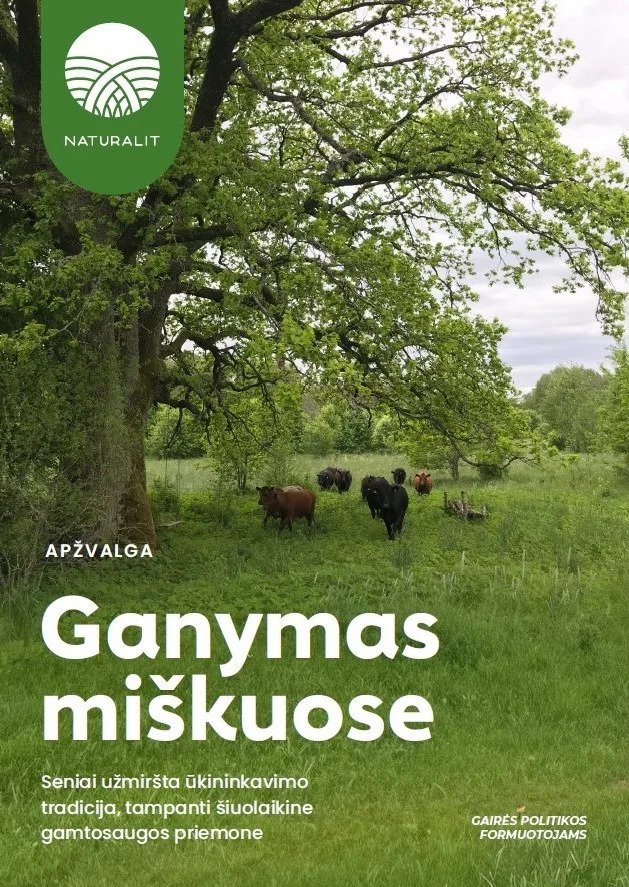
Photo: Egidijus Žalneravičius
The LIFE Integrated Project “Optimising the Management of the Natura 2000 Network in Lithuania” has presented a scientific review and guidelines for policy makers on “Grazing in forests – a long-forgotten farming tradition that is becoming a modern conservation tool”.
The e-publication discusses the historical context of forest pastures in Lithuania and their importance for the conservation of plant and animal species and their habitats. It also presents the measures currently being implemented and the need to provide options for further maintenance of the habitat network or restoration of new habitats.
The review was prepared by Vytautas Uselis (State Service for Protected Areas), Dr. Birutė Valatkienė (Environment Project Management Agency), Egidijus Žalneravičius (State Service for Protected Areas), Justas Gulbinas (Baltic Environment Forum), Lina Burbaitė (Ministry of the Environment), Monika Vyšniauskienė (Environment Project Management Agency) and Dr. Gintarė Grašytė (State Service for Protected Areas).
It helps to solve current problems
Justas Gulbinas, Chief Nature Conservation Expert at the Baltic Environment Forum, one of the compilers of the publication, said that it is a retrospective publication on a farming practice that existed in the past and is no longer actively used: “It introduces both policy makers and specialists, as well as the general public, to the history of the landscape in Lithuania – how it has evolved and the transformations that have taken place over the years due to the economic and social changes”.
The scientific review also focuses on open habitats. According to Gulbinas, wooded pastures are becoming a bridge between two ecosystems – forests and open habitats. In the past, they were not clearly separated as they are now. This breakthrough only came in the 19th century, when people made the distinction between forest, grassland, and arable land for economic reasons.
“We tend to have a short memory of the landscape. Five years go by, and we forget what came before. I think this publication will help us to understand that we are unwittingly destroying Lithuania’s historic landscape and the rare species that live there. Before it is too late, we need to find ways to preserve and nurture it,” he said.
Finally, the expert guidance will help policy makers to address the recent and pressing problems of grassland loss and animal welfare. It will also help raise awareness of agroforestry, which is still in its infancy in Lithuania, and of which grazing on wooded pastures could be one of its components.

Cover of the scientific review and guidelines for policy makers “Grazing in forests – a long-forgotten farming tradition that is becoming a modern conservation tool”
Grazing by large herbivores is important for the survival of many habitats and species
Vytautas Uselis, nature conservation expert (botanist) at the State Service for Protected Areas, echoed Mr Gulbinas. According to him, the problems related to livestock grazing are difficult to understand for many people today and are often surrounded by various stereotypes. For example, a few decades ago, botanists underestimated the importance of livestock grazing in meadows, grasslands and forests. In some places, it was even recommended that grazing should be discouraged for fear of the extinction of one or other protected plant species.
“Lithuania’s agricultural policy has changed since regaining its independence and joining the European Union. The drastic reduction in livestock grazing has revealed the negative consequences of this decision. It has become obvious that grazing is very important and that large herbivores are a key factor for the survival of many habitats and species,” said Uselis. – Grazing in forests is often opposed in many cases, even by naturalists. It is thought that the animal will spoil everything in the forest, but again, this is a very superficial view that shows how little we know about the processes that take place in forests.
He said that while many people think that the denser the forest, the more plant, insect and bird species should thrive, the opposite is true: “Lithuania’s forests have never been as dense, lush and continuous as they are now. This is a consequence of forestry activities, which are leading to the loss of many species”.
According to Uselis, although this issue has received increasing attention in Europe in recent years, it is still struggling to find its way into Lithuanian science and is not included in textbooks at higher education institutions: “The publication of this scientific review gives hope that it will accelerate the development of knowledge and encourage more research in this field. Perhaps it will also contribute to the emergence and development of the field of conservation biology in Lithuania, which has been successfully developed in Scandinavia”.
Funded by the European Union LIFE programme. The contents of this publication are the sole responsibility of and do not necessarily reflect the opinion of the European Union.
